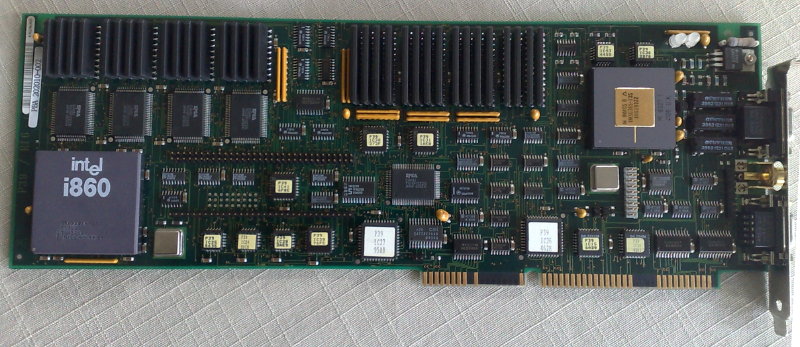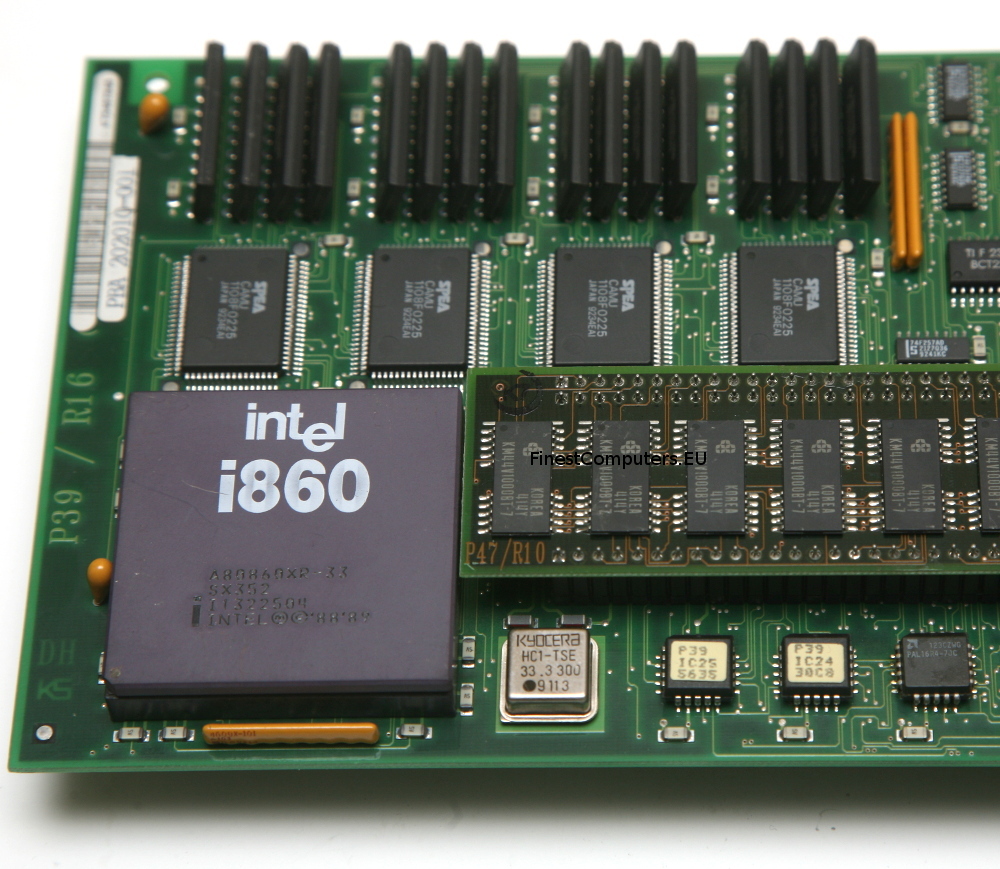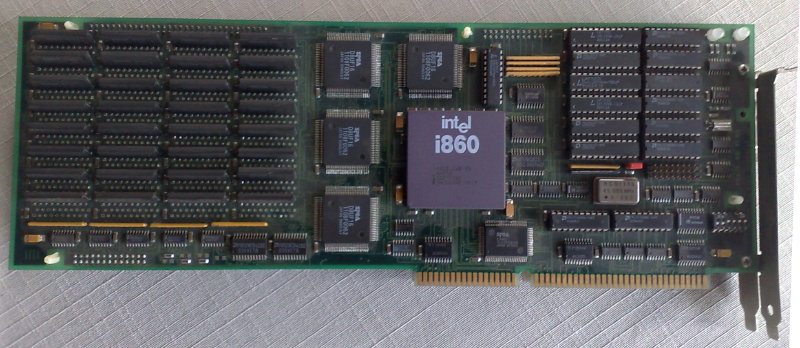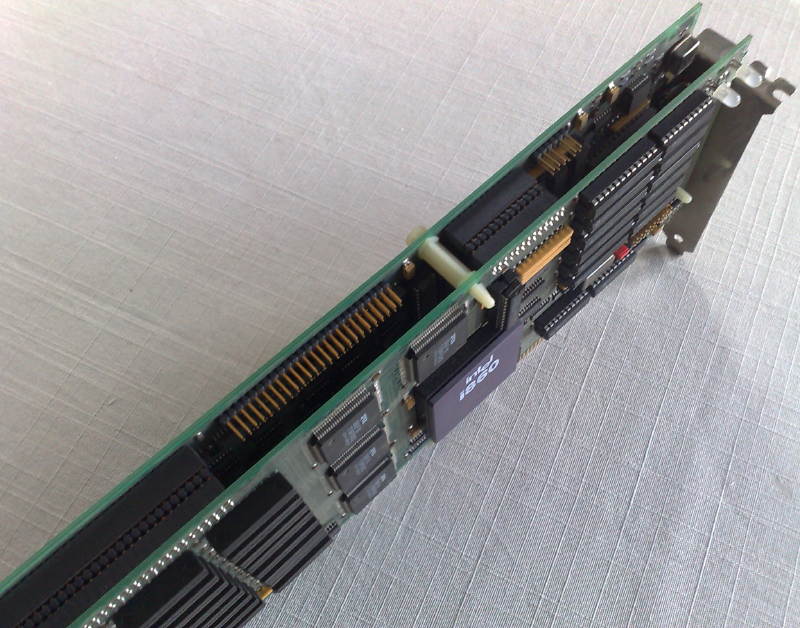Between 1990 and 1995 the German multimedia-card manufacturer SPEA was one of the leading companies in this sector (When ATI was comparably small and NVIDIA not even founded).
They offered a wide range of display-cards, from a simple ET4000 up to very expensive CAD/CAM cards using various graphic chips like the TIGA controllers, Hitachi ACRTC, Weitek, S3, 3DLabs and… of course the i860.
Later SPEA was bought by Diamond Multimedia and some employees started their own company to finalize the graphic chip they already started to design when being with SPEA (read more here… article in German, sorry).
Two SPEA cards using the i860 were built. The first was the
SPEA Fire
This full-size ISA card features a 33MHz i860 with 4MB own RAM as well as 2MB VRAM. An Inmos G364 graphics controller is in charge for creating a picture on the monitor – BTW that’s the last and fastest graphics controller which was manufactured by Inmos.
Theoretically, this card could be called an INMOS B020 on steroids.
As this is “just” a 3D subsystem, a standard VGA was still needed for all 2D stuff. Its video signal was then looped-through the SPEA Fire… just like the Voodoo cards did it some years later.
A recent photo I’ve found on ePay shows, that there was a proprietary memory expansion available, which has to be plugged next to the i860. Probably expanding the RAM to 8MB, which can be considered as an quite serious amount of RAM back in those days.
Interestingly the manual briefly touches the possibility to be programmed with own applications using Intels APX system. Sad enough, the APX is not included on the driver disks and was sold separately for a lot of money.
FGA860
The FGA860 is the bigger brother of the SPEA Fire. Actually it’s two boards sandwiched together: The one on top is -again- called the Fire-Board. But this time it is designed completely different. There is no RAMDAC or such… just the i860, RAM (16MB) and some custom- and bus-logic.
Behind this, there’s a full-blown TIGA card called FGA-4E, using a TMS34020/32Mhz with 4MB DRAM and 2MB VRAM. Not so usual is the also included VGA part on the FGA-4E. This way you can save an ISA slot for the needed VGA card.
The Fire-Board was available for 5700 German Marks, the FGA-4E added another hefty 10.820 Marks making a total of 16.520 Marks (1990/91 that was about US$ 8000)!
But for that money you got a “graphic subsystem” which was capable of 300.000 2-D vectors/s (10 Pixel long) and amazing 30.000 gouraud-shaded polygons/s (10 × 10 Pixels).
[Back then, that really was amazing… today every mobile phone might be better in 3D. Here are some numbers for comparison/amusement:
3DLabs GLINT 300SX: 500.000/300.000]
Here’s a view from the top… not really much to see. It’s very hard to pry those cards from each other. I guess, they were never intended to be separated again.
If you are in need of the drivers, I make them available here. It’s the IMHO most recent version from August 1994 including an AutoCAD 13 driver update.





Yeah, at WMD in Hamburg we use these for professional video animations for TV studios. For that purpose the output had to be “genlocked” – synchronized to the studio’s time code signal. So I made a board with a PLL which was plugged in the socket of the i860, which then was plugged on top, so that I was actually changing the processor clock in sync with the TV signal 🙂 … We put a lot of those into 19″ racks running all over the world in TV studios and for instance displaying those animated analog watches complete with anti-aliasing etc. Today of course you wouldn’t need all this, but at the time … Great fun.
Hey Jim! Wow, fascinating background-story! (Especially given I’m in Hamburg, too)
I bet you have nothing left from those days, right? So you were changing the CPU clock dynamically? And that worked reliably? 😮
Dear Axel and Jim,
I have an ISA-16 bus “SPEA 11/A HRCDB1 6400030” video card in my vintage hardware collection. It has a D-SUB output on the backplane and 4 small coaxial connectors. Is it possible to know more about this card? Thanks in advance!
Hey Tamas,
Mhh, the model number doesn’t ring a bell… what kind of Controller is built on that card?
Could it be one of their Hitachi HD63484 ACRTC cards?
Wow… what a card.
My first video card was a TIGA card with a TMS34010, I wrote a driver for Smalltalk/V using the MS MacroAssembler samples Digikey gave you. I was running 1024×768 at 16 bpp in 1988. It probably cost me $1800 for the card and the CRT.
I designed a TMS34020 based card at my first job out of college, I have to say that graphics card design was A LOT more fun back then.. now it’s just about placing a GPU down, memory… maybe a couple of connectors and a switching power supply and cross your fingers it works.
On the weekends I designed the first P9000 (Weitek 8720) video card for the Mac and converted it to VLB. It made Zeos the PC of the year with that card and landed me a job at Dell computer.
My boss at Zeos found out I was designing an 860 based video card for the Mac and deleted my account on the CAD system and put me in the lab. What a dick. “no one will ever user a GPU for computation” he said… boy was he wrong. It wasn’t too hard to leave Zeos after that.
Amazing… those stories are the reason I keep on allowing comments, even it’s a drag to review 90% bot-spam (despite several filters).
Thanks for sharing, Guy!
Great story. Thanks for sharing with us.
Hi Axel, very interesting. I loved playing with this card in recent days. I bought one from the first big check I got from my work as an author. I programmed the Mandelbrot for myself and a Raytracer all in assembler putting about 13MFlop/s for the Mandelprot and 6MFlop/s for the Raytracer on the road (as far as I remeber correctly).
Most annoying to me was that not all combinations of ASM calculations were possible with the intermediate registers loosing clocks by copy operations.
Maybe you remeber the KI/KR inputs of the multiplyer and the T input of the adder …
However: I have a different card than you (fully functionable) …
http://systemberatung.schwarzers.de/a.png
Have a great day, thanks for the memories
/Jesko
Hi Jesko,
Thanks for sharing and happy to revive memories 😉
…and you still have the card? It’s a more recent version than mine and stuck into a SPEA Graphiti FGA 860.4/HE it would form the FGA860GX “package”.
I guess you don’t have the software/code anymore, don’t you? Which development package did you use to code your Mandelbrot/Raytracer?
And yes, I (painfully) remember the multiplyer/adder “hassle”… I ran into that with the mandelbrot demo I did.
Hello,
So, there is Life out there. In 2023, I have the honor to be the owner of Hauppage 4860/33Mhz, that is still working. In 1995, I bought this system from a shop in Athens. After so many years I am trying to find a Linux/Unix or something that could take advantage of i860 (and Framebuffer) but nothing seems to be visible in the horizon.
I wonder, why Linux community doesn’t care to make something little about this cpu.
Never mind, the time has passed. Maybe, at the end of my career, I ‘ll try something my own.
If someone has any idea, please communicate with me.
Thank you!